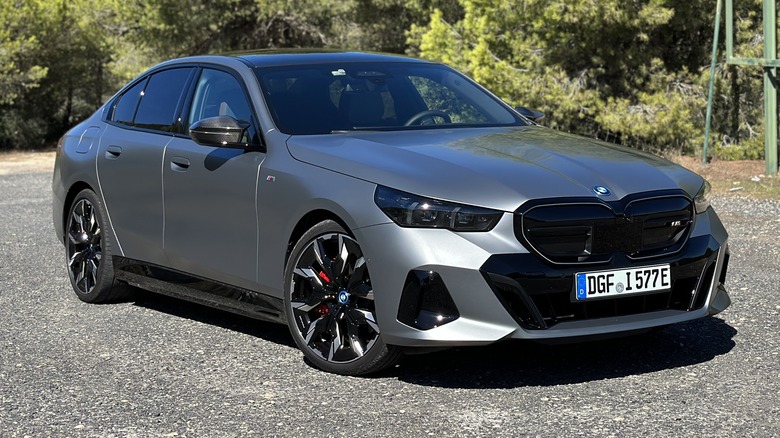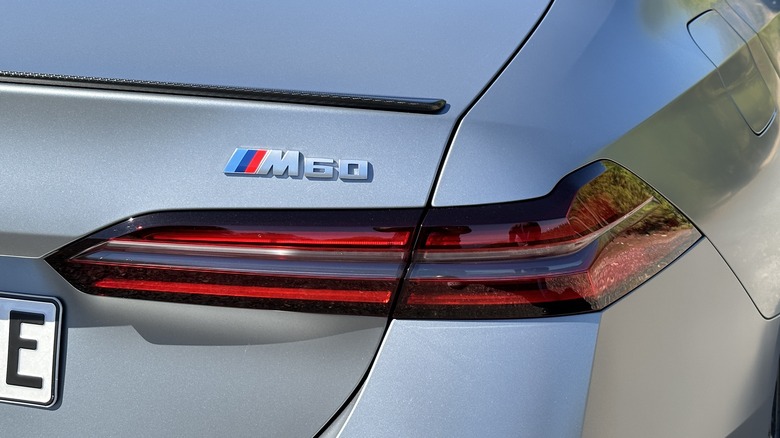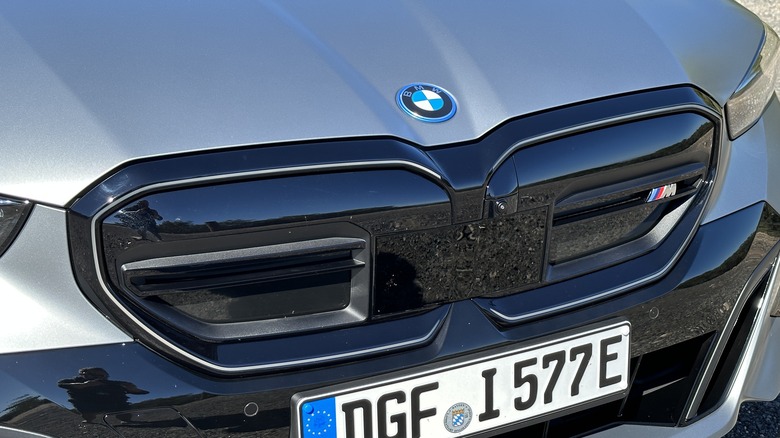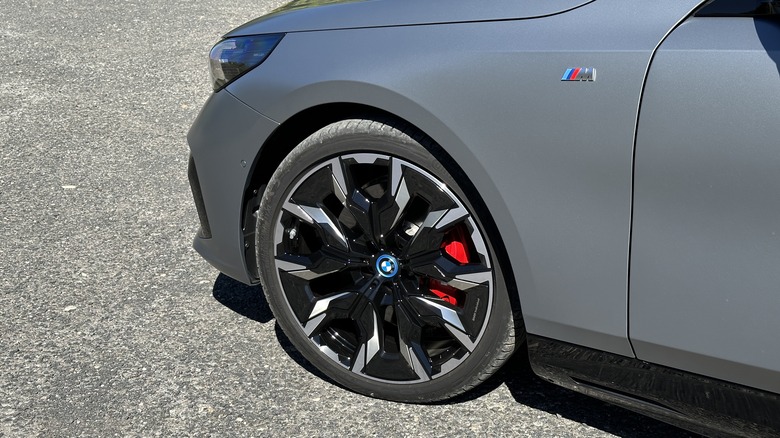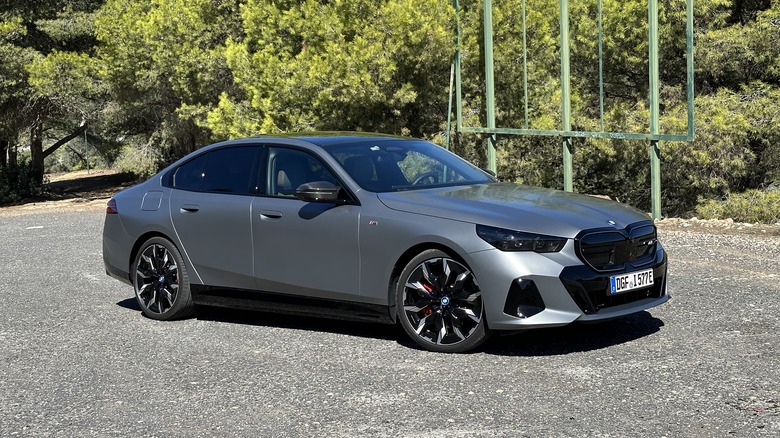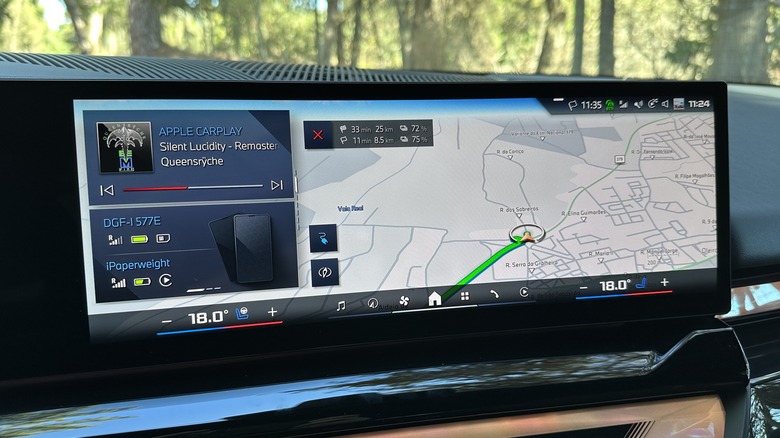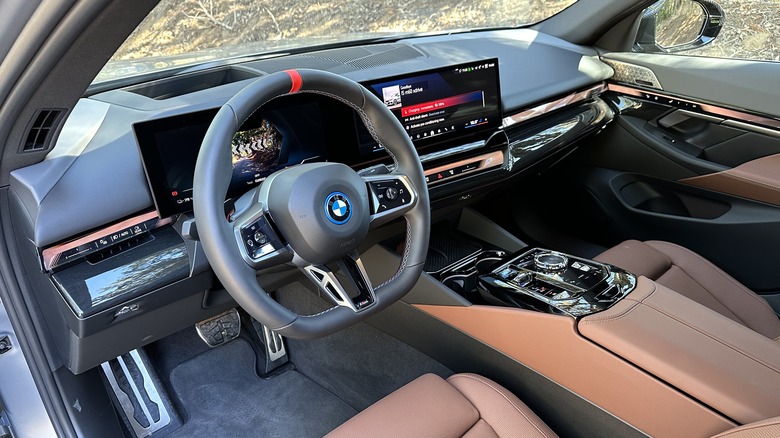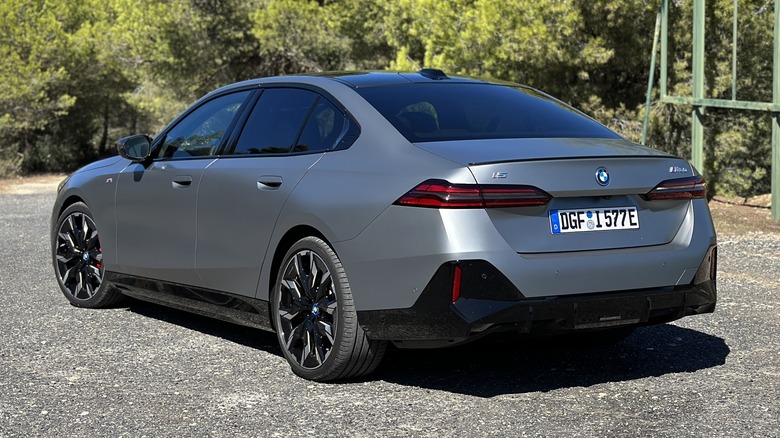2024 BMW i5 First Drive: The Luxury, Dynamics And Range To Make An Electric Winner
Last April, I flew home from France with a belly full of ratatouille and a positive impression of the new BMW i5. Though only a prototype at that point, BMW's new EV felt like a solid effort, ready and raring to battle the Mercedes-Benz EQE and Tesla Model S. And now that I've spent time with the production i5 along the Portuguese coast outside of Lisbon, I'm once again full of good vibes. And pastéis de nata. So many pastéis de nata.
The i5 is the fully electric version of the eighth-generation BMW 5 Series sedan that launches this fall. Like the larger 7 Series and i7, BMW designed one vehicle that could incorporate internal combustion, plug-in hybrid, and fully electric drivetrains, with only minor design differences setting them apart. It'll be a couple of months before I'll be able to test the gas-powered 5 Series variants, but the good things felt behind the wheel of the i5 will hopefully carry over to its dinosaur-fed counterparts, too.
Slightly bigger, slightly less attractive
The new 5 Series has grown in every dimension. It's 3.4 inches longer, 1.3 inches wider, and 1.1 inches taller than its predecessor, riding on an 0.8-inch longer wheelbase. The Five's new face looks nice in person — certainly better than the 7 Series, yeesh — but the rear has a chonky, blocky vibe that sort of reminds me of a stodgy Volkswagen. From every angle, the previous 5 Series is a more handsomely styled sedan.
Depending on the model, buyers can choose between 19-, 20- or 21-inch wheels, and the i5 has special aerodynamic designs that improve overall efficiency. Next year, BMW will launch a longroof 5 Series Touring that won't be coming to wagon-averse North America, but we will get a new high-performance M5 sedan, powered by the same plug-in hybrid V8 powertrain you'll find in the XM SUV.
Take your pick: i5 eDrive40 or i5 M60 xDrive
The i5 will initially be offered in single-motor eDrive40 and dual-motor M60 xDrive variants, both of which are powered by a lithium-ion battery with 81.2 kilowatt-hours of usable energy. According to the EPA, the i5 eDrive40 has a driving range of anywhere from 270 to 295 miles, depending on wheel size, while the i5 M60 xDrive lowers that spectrum to 240 to 256 miles, again dictated by how much metal you want in your arches. Across the board, every i5 can DC fast-charge at speeds up to 205 kW — that's more than the larger and more luxurious i7, which tops out at 195 kW.
In the 2024 i5 eDrive40, a single electric motor mounted on the rear axle produces 335 horsepower and 295 pound-feet of torque. This'll scoot the 4,916-pound eDrive40 to 60 mph in a respectable 5.7 seconds, and this rear-wheel-drive sedan tops out at an electronically limited 120 mph.
The 2024 i5 M60, on the other hand, is significantly more powerful, with a dual-motor, all-wheel-drive configuration that offers 593 hp and 586 lb-ft of torque. That's enough extra thrust to reduce the i5's 0-to-60 time by a full 2 seconds, despite the M60's additional 331 pounds of ballast. A noticeable uptick, for sure.
Great to drive, no matter the output
While I totally get the allure of the 593-hp i5 M60, I can't see anyone being disappointed by the i5 eDrive40. No, it doesn't have the same active roll stabilization as the more powerful M60, but the i5 eDrive40 is still perfectly happy to be flung around on narrow Portuguese b-roads with very little body motion. Every i5 comes standard with a self-leveling rear air suspension, and the eDrive40 can be equipped with electronically controlled front dampers, though switching between the standard and Sport settings on a car so equipped, I can't say there's an appreciable difference.
Instead, the i5 eDrive40 has a pleasant ride quality — nice and comfortable, even on my example's largest-available 21-inch wheels. The steering is somewhat light and relatively numb on center, but the i5 responds quickly to inputs and genuinely feels more engaging than its key rivals from Mercedes-Benz and Tesla.
Behind the wheel of an i5 M60 xDrive, the experience is noticeably more exciting — and I'm not just talking about the extra power. There's a lot more pep in this sedan's step, and better communication through the steering thanks to the active torque being delivered to the front axle. Interestingly, the M60 has a higher steering ratio than the eDrive40 — 15.7:1 compared to 15.2 — but the car feels better balanced and more agile overall. Credit also goes to the 2.5-degree rear-axle steering, which helps the i5 through corners. I can't wait to see how this chassis forms the basis for a rowdy M5.
Strong regenerative braking can be dialed in by driving in B mode, or setting the regen level to high through the iDrive 8.5 infotainment system. I do recommend setting the regen level yourself, no matter how you like it, because the standard adaptive mode is a little wonky on winding roads. It'll use the car's driver-assistance sensors and GPS location data to preemptively increase or decrease energy recuperation based on the road ahead, which can provide inconsistent braking effort. At least the i5's brake pedal doesn't automatically move to mimic brake pressure, a stupid feature Mercedes insists upon in its EVs.
Improved hands-free tech
BMW's excellent Highway Assistant gets a new trick up its sleeve for the i5: automatic, hands-free lane changes. The ability for a car to change lanes on its own isn't new, but BMW's gesture-based activation is. When the system senses you might want to change lanes, it'll display the request on the digital gauge cluster and in the head-up display, and if you want to activate the motion, all you have to do is glance at the corresponding mirror. Don't want to change lanes? Just keep looking straight ahead. It's sort of a novelty, since you can also activate lane changes by hitting the turn signal, but I suppose if the trope about BMW drivers not using their blinkers is true, this is one way to take some guesswork out of the process.
The automatic lane-change tech will become available to existing Highway Assistant users (read: 7 Series and i7 owners) through an over-the-air update. As for when BMW will venture into the brave new world of Level 3 autonomy — Highway Assistant is still officially a Level 2 system, let's call it Level 2+ — that's still very much TBD, despite prototypes undergoing testing.
New infotainment and... video games?
The 5 Series' other big tech headline is the switch to iDrive 8.5, which is effectively an updated version of the outstanding and menu-heavy iDrive 8.0. The big difference here is a redesigned home screen with widgets placed on top of the navigation map, and there's a row of commonly used buttons along the bottom of the display, giving you better access to things like audio and climate controls. Apple CarPlay and Android Auto are still included — wirelessly connecting, too — and all i5 models come with both a 12.3-inch digital gauge cluster and 14.9-inch central touchscreen.
BMW also introduces its new AirConsole software with the launch of the 5 Series, which is pretty much the company's way of saying, "Hey, we know it sucks to sit and charge, so here's something to do in the meantime." AirConsole lets you scan a QR code to play a bunch of different video games on the i5's multimedia screen, including a knockoff Mario Kart, among other titles, which I'm lovingly referring to as Moriokort (you know, like Magnetbox or Sorny.). BMW says up to seven people can connect and play — which is more people than you can fit in an i5, for reference — but, I don't know, call me skeptical, won't people just continue to do what they normally do and mindlessly scroll TikTok on their phones?
Leather-free interior
The i5's interior is completely vegan, done up in a new composite material BMW calls Veganza — not to be confused with Leganza, the illustrious Daewoo sedan from the turn of the Millennium. This fabric feels great, and the i5's seats are incredibly supportive and comfortable. I honestly prefer this material over leather.
Overall, the 5 Series' cabin takes a lot of cues from the larger 7 Series, with different backlit panels that can change color depending on pre-set driving "moods." The glass rotary controller for the iDrive infotainment system is especially cool, and I like that the wireless charging tray ahead of the cupholders has spaces for two smartphones. The i5's rear seats are plenty spacious, too, and there's 17.3 cubic feet of space in the trunk — only a smidge less than what you get in the gas-powered 5 Series.
2024 BMW i5: Coming this fall
The 2024 i5 goes into production at BMW's Dingolfing, Germany facility later this year, and it should be available at U.S. dealers by the fall. A base i5 eDrive40 starts at $67,795 including $995 for destination, which isn't bad, considering a base Mercedes-Benz EQE 350+ starts at $76,050 and the refreshed-but-still-fairly-outdated and often poorly built Tesla Model S starts at $76,380. If you want the hotter i5 M60, that'll be $85,095 before options (and you just know BMW won't be short on options).
There's no big reason to fault the new BMW i5: it's a solid midsize luxury sedan with strong electric power, competitive range, and a plush cabin. And hey, if you're not quite ready to take the plunge on an EV, there's always the gas-powered 530i, 530i xDrive and 540i xDrive. Those'll no doubt be just at satisfying.
